
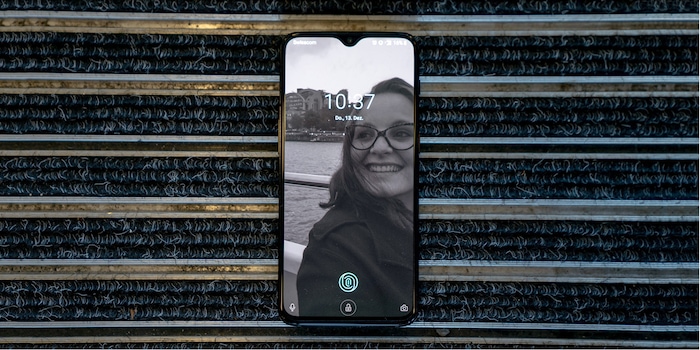
OnePlus 6T: "Warning, I'm a flagship killer". Really?
OnePlus has named its latest smartphone the flagship killer. The test shows whether the OnePlus 6T delivers what the Chinese manufacturer promises.
In May 2018, the still relatively unknown manufacturer from China launched the OnePlus 6, a phone that impresses. Because you get a lot of performance for very little money. Not as much as the current flagship smartphones from Apple, Samsung or Huawei - but still.
Half a year later, OnePlus follows up with the OnePlus 6T. Its price is a challenge. Can it give the big boys a run for their money?

About the remaining OnePlus 6T models.
Marketing collects plus points
OnePlus' marketing department has a broad chest. At the presentation of the new phone in October 2018, Kyle Kiang, Head of North America Region and Global Marketing, said: "Technology shouldn't stand out or shine. It should feel natural and never get in the way". A little dig at the competition.
OnePlus has also designed the packaging very confidently. A red ribbon explains the term "OnePlus Community" as if it were a dictionary noun: "The OnePlus Community is a group with an insane amount of know-how and a superior taste for the very best technology."
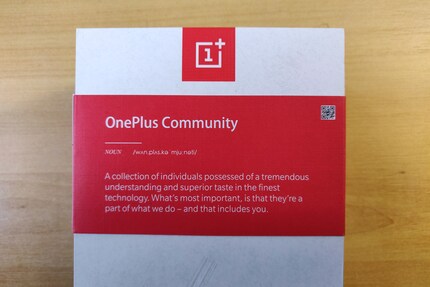
That's about the nicest thing a smartphone has ever said to me.
But there's more. Inside the packaging itself is a letter written by OnePlus founder and CEO Pete Lau, in which he addresses the buyers to butter them up even more. The stickers enclosed take the cake: "Warning: I'm a flagship killer". This is so unexpectedly stupid, cheeky and ridiculous that I can't help but find it sadly awesome.
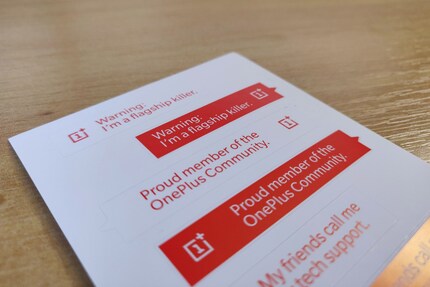
Hype aside. What can the successor to the OnePlus 6 do?
First impressions and key facts
The mobile feels smooth. The smartphone also looks good. Although it doesn't have a rounded display like Samsung's Galaxy S9+, the 6.41-inch display still covers almost the entire front. I prefer it that way anyway. Only a small camera protrudes into the picture at the top - a tiny little notch, much smaller than on the OnePlus 6 - which never gets in the way. There is no physical home button. Instead, there is Screen Unlock, i.e. a fingerprint sensor under the glass, which is also new.
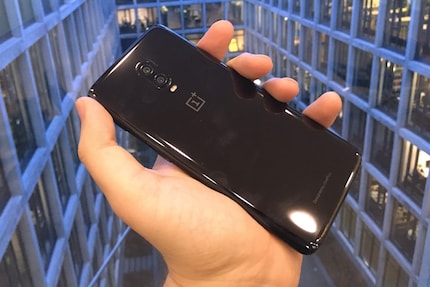
On the back of the phone are two camera lenses and the OnePlus logo, which the Swiss Federal Institute of Intellectual Property, or IPI for short, has been looking into. As we now know, the logo does not need a sticker. .
I like the simplicity of the colour - Mirror Black. Unlike my editorial colleague Dominik Bärlocher, I'm not a fan of the increasingly gaudy, sparkling colours of the Chinese competition from Huawei or Honor.
While I put on my OnePlus 6T, I skim through the specs of the new phone.
- Operating system: OxygenOS, based on Android 9 Pie
- CPU: Qualcomm Snapdragon 845 à 2.8 GHz
- GPU: Adreno 630
- Memory: 6 GB, optionally 8 GB
- Internal memory: 128 GB, optionally 256 GB, not expandable
- Battery: 3700 mAh, Dash Charge (5V 4A)
- Dual Sim: Yes
- Resolution: 2340×1080 pixels
- Aspect ratio: 19.5:9
- Corning Gorilla Glass 6
- 3.5mm jack: No, but USB-C dongle is included
- No IP certifications
This makes it clear: The phone is fast and has a lot of power. But: In terms of hardware, practically everything has remained the same compared to its predecessor. Except for the larger battery and the slightly improved RAM.
Some people see the omission of the 3.5 mm jack as an affront. I can understand this despite the USB-C dongle supplied. After all, OnePlus co-founder Carl Pei conducted a survey on the topic in March 2018 via Twitter and received a clear answer to his question.

"Do you like headphone jacks?" he asked. 88 per cent of the 19,374 participants answered in the affirmative. Nevertheless, the 3.5mm jack no longer exists. I'm not so sure how seriously OnePlus really takes its Community
Runs smoothly and looks stunningly beautiful
I tested the 128 GB version with 8 GB RAM. Together with the Snapdragon 845 from Qualcomm, the smartphone runs incredibly smoothly and without any stuttering. Screen and face unlock? Super fast. The OnePlus 6T also features "Smart Boost": Apps that are used repeatedly are stored in RAM - RAM reads and writes faster than the internal phone memory - and start up to 20 per cent faster as a result. I notice this especially with WhatsApp and Spotify. According to the manufacturer, Smart Boost should benefit gamers in particular thanks to faster loading times in games.
The AMOLED display really knocked my socks off. The colours are as vibrant and rich as I last saw on the Samsung A8. Compared to AMOLED, LCDs look downright pale. What's more, the OnePlus display is big. Really big. At 6.41 inches, it outperforms the 6.28-inch display of the OnePlus 6. 19.5:9 aspect ratio, which I have only seen on the Huawei Mate 20 Pro.

The pixel mass of the phone itself, with its 2340×1080 pixels, is about half the size of the HTC U12+. It doesn't sound like much, but I didn't notice any difference in terms of sharpness. With a pixel density of 402 ppi (points per inch), OnePlus has almost the same pixel density as Huawei's P20 Pro anyway. In addition, each individual pixel requires computing power and therefore more power. This drains the battery. In fact, the 3700 mAh battery of the OnePlus 6T easily lasts one to two days with intensive use. In comparison, the HTC U12+ barely lasted a day. As you can see, more pixel mass can also be a disadvantage.
Apropos: Charging is really fast thanks to the Dash Charger. In my case, the OnePlus phone charges from around 15 to 100 per cent in just under an hour. But there's no wireless charging. A missed opportunity, especially for the self-proclaimed flagship killer.
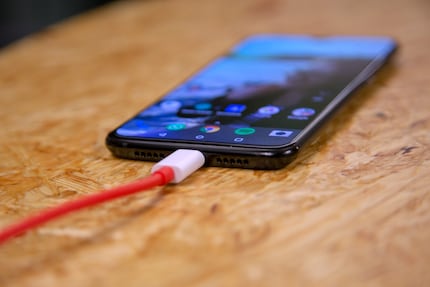
The built-in speakers are just okay. When I use it to watch videos or make a phone call via the speakers, it doesn't rattle as much as a budget phone à la Honor 7x, but the sound is nowhere near the quality of the HTC U12+. However, the recording quality of phone calls seems to be superior to the HTC U12+. My girlfriend has told me on several occasions that she can hear my voice much more clearly than with other test phones. Especially when the hands-free function is activated.
The camera is okay - no more, no less
As with its predecessor, Sony had a hand in the main and front cameras. In fact, the hardware is no different from the OnePlus 6, i.e. the dual camera system on the back consists of a 16-megapixel camera with a ƒ/1.7 aperture and a 20-megapixel camera with a ƒ/2.6 aperture. There is also Dual Pixel PDAF - for fast autofocus - and an optical image stabiliser. The front camera offers 16 megapixels and an electronic image stabiliser. The mobile can take videos in UHD resolution with auto-HDR support.
So what's new?
First and foremost, HDR shots and photos in low light are said to have been improved. As I haven't tested a OnePlus 6 yet, I can't make any comparative statements on this point. Nevertheless, I have tried out the camera.
In automatic mode, the camera shows balanced colour reproduction with lots of detail.

Below the same image as above but about 300% zoom.

Depending on the subject and light, photos always look a little pale and sometimes have a slight green tint. This can be corrected in Pro mode by adjusting the white balance. Nevertheless, I liked the set-up better overall on the HTC U12+, which I tested before the OnePlus 6T.

In "Portrait mode" you can then add artificial depth of field. This works quite well with the main and auxiliary camera.

With the front camera, the software sweats more in "portrait mode" than I would have thought. In this example, I think I made it quite easy for the camera: Black jumper against a white background.

I notice a kind of shimmer around my silhouette when I zoom in. The washed out ends of my hair, on the other hand, are something that happens pretty much everywhere.

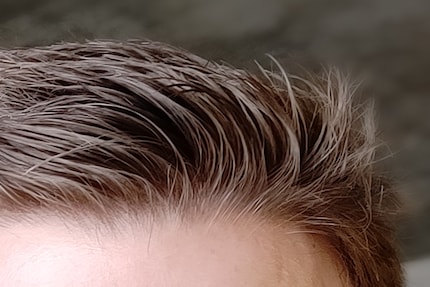
Back to the main camera on the back. The ƒ/1.70 aperture is low for this price category. For you, this means that you can take photos in low light that don't look blurred. I take two photos in the evening: once in automatic mode and once with "night mode" activated.

In automatic mode above, the photo already looks amazingly good. Especially the yellow of the lanterns comes across well.
In night mode below, the sky in particular looks a little bluer. Otherwise, there are hardly any noticeable differences, apart from the moving brake lights of the cars, which are pulled apart due to the long exposure time.

The advantages of night mode only become apparent to me when zooming in: while details on the Prime Tower appear washed out in automatic mode, they are clearly sharper in night mode.


All in all, I think the camera setup is good, even if not outstandingly good. I think Huawei, HTC and Google's Pixel 3 are still a step ahead.
Conclusion: The phone is a lot of fun

Is the OnePlus 6T a flagship killer? Compared to its predecessor, it only has a few new features: improved battery and RAM as well as the slightly larger display. The phone even has the same camera setup on the hardware side; only the software is said to have undergone minor improvements, which I can't quantify due to my lack of testing experience with the OnePlus 6.
But ignoring the existence of its predecessor - which is no longer in production anyway - I realise that the OnePlus 6T is a fast-paced smartphone with a hell of a lot of power, no-frills software and a pleasantly understated design. The battery easily holds out and doesn't run out of power even after several hours. Rarely have I had so much fun testing a phone as I have here. And all at a really fair price. The outrageously cheeky appearance of OnePlus Marketing is the icing on the cake.
So a flagship killer after all? No. The lack of the 3.5 mm jack and wireless charging as well as the less than outstanding camera speak against it. Apart from that, the smartphone has no IP certifications, which I find quite strange for a top-of-the-range phone. Anyway, to be a "killer", the smartphone would not only have to be just as good, but so much better that everything else becomes superfluous. <p
I'm an outdoorsy guy and enjoy sports that push me to the limit – now that’s what I call comfort zone! But I'm also about curling up in an armchair with books about ugly intrigue and sinister kingkillers. Being an avid cinema-goer, I’ve been known to rave about film scores for hours on end. I’ve always wanted to say: «I am Groot.»



